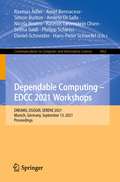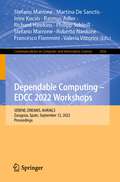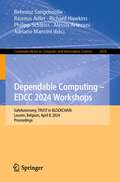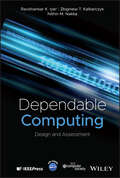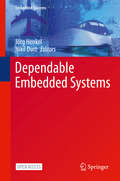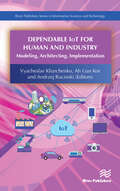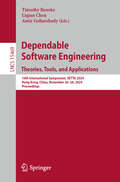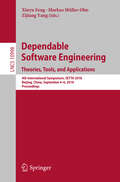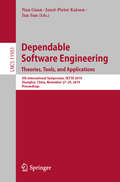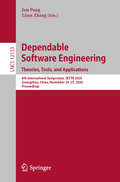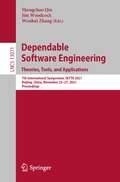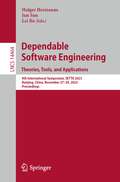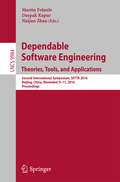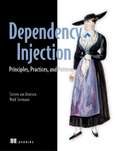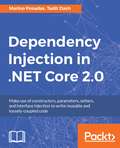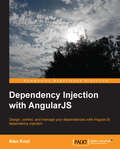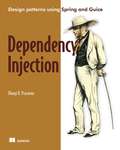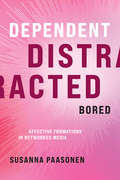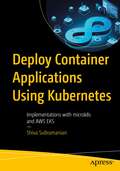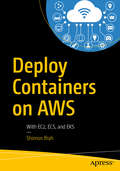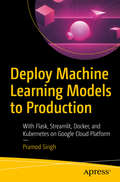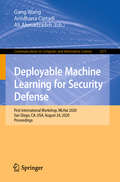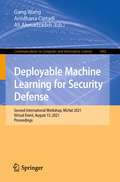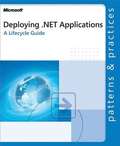- Table View
- List View
Dependable Computing - EDCC 2021 Workshops: DREAMS, DSOGRI, SERENE 2021, Munich, Germany, September 13, 2021, Proceedings (Communications in Computer and Information Science #1462)
by Daniel Schneider Amel Bennaceur Simon Burton Rasmus Adler Nicola Nostro Rasmus Løvenstein Olsen Amleto Di Salle Selma Saidi Philipp Schleiss Hans-Peter SchwefelThis book constitutes refereed proceedings of the Workshops of the 17th European Dependable Computing Conference, EDCC: Second Worskhop on Dynamic Risk Management for Autonomous Systems, DREAMS 2021, Third Workshop on Dependable Solutions for Intelligent Electricity Distribution Grids, DSOGRI 2021, 13th Workshop on Software Engineering for Resilient Systems, SERENE 2021, held in September 2021. Due to the COVID-19 pandemic the workshops were held virtually. The 14 workshop papers presented were thoroughly reviewed and selected from 22 submissions. The workshop papers complement the main conference topics by addressing dependability or security issues in specic application domains or by focussing in specialized topics, such as system resilience.
Dependable Computing – EDCC 2022 Workshops: SERENE, DREAMS, AI4RAILS, Zaragoza, Spain, September 12, 2022, Proceedings (Communications in Computer and Information Science #1656)
by Valeria Vittorini Richard Hawkins Francesco Flammini Roberto Nardone Stefano Marrone Rasmus Adler Philipp Schleiß Martina De Sanctis Imre KocsisThis book constitutes refereed proceedings of the Workshops of the 18th European Dependable Computing Conference, EDCC: 13th Workshop on Software Engineering for Resilient Systems, SERENE 2022; Third Worskhop on Dynamic Risk Management for Autonomous Systems, DREAMS 2022, Third Workshop on Artificial Intelligence for Railways, AI4RAILS, held in Zaragoza, Spain, in September 2022. The 11 workshop papers presented were thoroughly reviewed and selected from 22 submissions. The workshop papers complement the main conference topics by addressing dependability or security issues in specic application domains or by focussing in specialized topics, such as system resilience.
Dependable Computing – EDCC 2024 Workshops: SafeAutonomy, TRUST in BLOCKCHAIN, Leuven, Belgium, April 8, 2024, Proceedings (Communications in Computer and Information Science #2078)
by Adriano Mancini Richard Hawkins Alessia Arteconi Rasmus Adler Philipp Schleiss Behrooz SangchoolieThis book constitutes the refereed proceedings of Workshops held at the 19th European Dependable Computing Conference, EDCC 2024: First Workshop on Safe Autonomous Systems, SafeAutonomy 2024, and the First Workshop on the Role of TRUST in the implementation of Digital Technologies: Blockchain Technology and Artificial Intelligence in Smart Cities, TRUST IN BLOCKCHAIN 2024. The 13 workshop papers presented in this book were thoroughly reviewed and selected from 14 submissions. The TRUST IN BLOCKCHAIN workshop accepted extended abstract submissions, whereas the SafeAutonomy workshop accepted regular technical papers, case studies, PhD forum papers, as well as position papers. They deal with latest research results on theory, techniques, systems, and tools for the design, validation, operationand evaluation of dependable and secure computing systems.
Dependable Computing: Design and Assessment (IEEE Press)
by Ravishankar K. Iyer Zbigniew T. Kalbarczyk Nithin M. NakkaDependable Computing Covering dependability from software and hardware perspectives Dependable Computing: Design and Assessment looks at both the software and hardware aspects of dependability. This book: Provides an in-depth examination of dependability/fault tolerance topics Describes dependability taxonomy, and briefly contrasts classical techniques with their modern counterparts or extensions Walks up the system stack from the hardware logic via operating systems up to software applications with respect to how they are hardened for dependability Describes the use of measurement-based analysis of computing systems Illustrates technology through real-life applications Discusses security attacks and unique dependability requirements for emerging applications, e.g., smart electric power grids and cloud computing Finally, using critical societal applications such as autonomous vehicles, large-scale clouds, and engineering solutions for healthcare, the book illustrates the emerging challenges faced in making artificial intelligence (AI) and its applications dependable and trustworthy. This book is suitable for those studying in the fields of computer engineering and computer science. Professionals who are working within the new reality to ensure dependable computing will find helpful information to support their efforts. With the support of practical case studies and use cases from both academia and real-world deployments, the book provides a journey of developments that include the impact of artificial intelligence and machine learning on this ever-growing field. This book offers a single compendium that spans the myriad areas in which dependability has been applied, providing theoretical concepts and applied knowledge with content that will excite a beginner, and rigor that will satisfy an expert. Accompanying the book is an online repository of problem sets and solutions, as well as slides for instructors, that span the chapters of the book.
Dependable Embedded Systems (Embedded Systems)
by Jörg Henkel Nikil DuttThis Open Access book introduces readers to many new techniques for enhancing and optimizing reliability in embedded systems, which have emerged particularly within the last five years. This book introduces the most prominent reliability concerns from today’s points of view and roughly recapitulates the progress in the community so far. Unlike other books that focus on a single abstraction level such circuit level or system level alone, the focus of this book is to deal with the different reliability challenges across different levels starting from the physical level all the way to the system level (cross-layer approaches). The book aims at demonstrating how new hardware/software co-design solution can be proposed to ef-fectively mitigate reliability degradation such as transistor aging, processor variation, temperature effects, soft errors, etc.Provides readers with latest insights into novel, cross-layer methods and models with respect to dependability of embedded systems;Describes cross-layer approaches that can leverage reliability through techniques that are pro-actively designed with respect to techniques at other layers;Explains run-time adaptation and concepts/means of self-organization, in order to achieve error resiliency in complex, future many core systems.
Dependable IoT for Human and Industry: Modeling, Architecting, Implementation (River Publishers Series In Information Science And Technology Ser.)
by Vyacheslav Kharchenko Andrzej Rucinski Ah Lian KorThere are numerous publications which introduce and discuss the Internet of Things (IoT). In the midst of these, this work has several unique characteristics which should change the reader’s perspective, and in particular, provide a more profound understanding of the impact of the IoT on society. Dependable IoT for Human and Industry covers the main aspects of Internet of Things and IoT based systems such as global issues of applications, modeling, development and implementation of dependable IoT for different human and industry domains. Technical topics discussed in the book include: Introduction in Internet of vital and trust Things Modelling and assessment techniques for dependable and secure IoT systems Architecting and development of IoT systems Implementation of IoT for smart cities and drone fleets; business and blockchain, transport and industry Training courses and education experience on Internet and Web of ThingThe book contains chapters which have their roots in the International Conference IDAACS 2017, and Workshop on Cyber Physical Systems and IoT Dependability CyberIoT-DESSERT 2017.
Dependable Software Engineering. Theories, Tools, and Applications: 10th International Symposium, SETTA 2024, Hong Kong, China, November 26–28, 2024, Proceedings (Lecture Notes in Computer Science #15469)
by Timothy Bourke Liqian Chen Amir GoharshadyThis book constitutes the refereed proceedings of the 10th International Symposium on Dependable Software Engineering. Theories, Tools, and Applications, SETTA 2024, held in Hong Kong, China, during November 26–28, 2024. The 21 full papers included in this book were carefully reviewed and selected from 47 submissions. The purpose of the SETTA symposium series is to bring international researchers together to exchange research results and ideas on bridging the gap between formal methods and software engineering.
Dependable Software Engineering. Theories, Tools, and Applications: 4th International Symposium, Setta 2018, Beijing, China, September 4-6, 2018, Proceedings (Lecture Notes in Computer Science #10998)
by Xinyu Feng Markus Müller-Olm Zijiang YangThis book constitutes the proceedings of the Third International Symposium on Dependable Software Engineering: Theories, Tools, and Applications, SETTA 2018, held in Beijing, China, in September 2018. The 9 full papers presented together with 3 short papers were carefully reviewed and selected from 22 submissions. The purpose of SETTA is to provide an international forum for researchers and practitioners to share cutting-edge advancements and strengthen collaborations in the field of formal methods and its interoperability with software engineering for building reliable, safe, secure, and smart systems.
Dependable Software Engineering. Theories, Tools, and Applications: 5th International Symposium, SETTA 2019, Shanghai, China, November 27–29, 2019, Proceedings (Lecture Notes in Computer Science #11951)
by Nan Guan Jun Sun Joost-Pieter KatoenThis book constitutes the proceedings of the 5th International Symposium on Dependable Software Engineering: Theories, Tools, and Applications, SETTA 2019, held in Shanghai, China, in November 2019. The 8 full papers presented were carefully reviewed and selected from 26 submissions. They present cutting-edge advancements in the field of formal methods and its interoperability with software engineering and focus on the application of formal techniques and tools for building reliable, safe, secure, and smart systems with multi-dimensional complexities.
Dependable Software Engineering. Theories, Tools, and Applications: 6th International Symposium, SETTA 2020, Guangzhou, China, November 24–27, 2020, Proceedings (Lecture Notes in Computer Science #12153)
by Lijun Zhang Jun PangThis book constitutes the proceedings of the 6th International Symposium on Dependable Software Engineering, SETTA 2020, held in Guangzhou, China, in November 2020. The 10 full and 1 short paper included in this volume were carefully reviewed and selected from 20 submissions. They deal with latest research results and ideas on bridging the gap between formal methods and software engineering.
Dependable Software Engineering. Theories, Tools, and Applications: 7th International Symposium, SETTA 2021, Beijing, China, November 25–27, 2021, Proceedings (Lecture Notes in Computer Science #13071)
by Shengchao Qin Jim Woodcock Wenhui ZhangThis book constitutes the proceedings of the 7th International Symposium on Dependable Software Engineering, SETTA 2021, held in Beijing, China, in November 2021. The 16 full papers in this volume were carefully reviewed and selected from 39 submissions, and are presented with 3 abstracts of keynote speeches. They deal with latest research results and ideas on bridging the gap between formal methods and software engineering.
Dependable Software Engineering. Theories, Tools, and Applications: 8th International Symposium, SETTA 2022, Beijing, China, October 27-29, 2022, Proceedings (Lecture Notes in Computer Science #13649)
by Jean-Pierre Talpin Wei DongThis book constitutes the proceedings of the 8th International Symposium on Dependable Software Engineering, SETTA 2022, held in Beijing, China, in October 2022.The 11 full papers and 3 short papers in this volume were carefully reviewed and selected from 29 submissions, and are presented with 3 abstracts of keynote speeches. They deal with latest research results and ideas on bridging the gap between formal methods and software engineering.
Dependable Software Engineering. Theories, Tools, and Applications: 9th International Symposium, SETTA 2023, Nanjing, China, November 27–29, 2023, Proceedings (Lecture Notes in Computer Science #14464)
by Jun Sun Lei Bu Holger HermannsThis book constitutes the proceedings of the 9th International Symposium on Dependable Software Engineering, SETTA 2023, held in Nanjing, China, during November 27-29, 2023. The 24 full papers presented in this volume were carefully reviewed and selected from 78 submissions. They deal with latest research results and ideas on bridging the gap between formal methods and software engineering.
Dependable Software Engineering: Theories, Tools, and Applications
by Martin Fränzle Naijun Zhan Deepak KapurThis book constitutes the refereed proceedings of the Second International Symposium on Dependable Software Engineering: Theories, Tools, and Applications, SETTA 2016, held in Beijing, China, in November 2016. The 17 full papers presented together with 3 short papers were carefully reviewed and selected from 58 submissions. The aim of the symposium is to bring together international researchers and practitioners in the field of software technology. Its focus is on formal methods and advanced software technologies, especially for engineering complex, large-scale artifacts like cyber-physical systems, networks of things, enterprise systems, or cloud-based services.
Dependency Injection Principles, Practices, and Patterns
by Mark Seemann Steven van DeursenSummaryDependency Injection Principles, Practices, and Patterns teaches you to use DI to reduce hard-coded dependencies between application components. You'll start by learning what DI is and what types of applications will benefit from it. Then, you'll work through concrete scenarios using C# and the .NET framework to implement DI in your own projects. As you dive into the thoroughly-explained examples, you'll develop a foundation you can apply to any of the many DI libraries for .NET and .NET Core.Purchase of the print book includes a free eBook in PDF, Kindle, and ePub formats from Manning Publications.About the TechnologyDependency Injection (DI) is a great way to reduce tight coupling between software components. Instead of hard-coding dependencies, such as specifying a database driver, you make those connections through a third party. Central to application frameworks like ASP.NET Core, DI enables you to better manage changes and other complexity in your software.About the BookDependency Injection Principles, Practices, and Patterns is a revised and expanded edition of the bestselling classic Dependency Injection in .NET. It teaches you DI from the ground up, featuring relevant examples, patterns, and anti-patterns for creating loosely coupled, well-structured applications. The well-annotated code and diagrams use C# examples to illustrate principles that work flawlessly with modern object-oriented languages and DI libraries.What's InsideRefactoring existing code into loosely coupled codeDI techniques that work with statically typed OO languagesIntegration with common .NET frameworksUpdated examples illustrating DI in .NET CoreAbout the ReaderFor intermediate OO developers.About the AuthorsMark Seemann is a programmer, software architect, and speaker who has been working with software since 1995, including six years with Microsoft. Steven van Deursen is a seasoned .NET developer and architect, and the author and maintainer of the Simple Injector DI library.Table of ContentsPART 1 Putting Dependency Injection on the mapThe basics of Dependency Injection: What, why, and howWriting tightly coupled code Writing loosely coupled codePART 2 CatalogDI patternsDI anti-patternsCode smellsPART 3 Pure DIApplication compositionObject lifetimeInterceptionAspect-Oriented Programming by designTool-based Aspect-Oriented ProgrammingPART 4 DI ContainersDI Container introductionThe Autofac DI ContainerThe Simple Injector DI ContainerThe Microsoft.Extensions.DependencyInjection DI Container
Dependency Injection in .NET Core 2.0
by Marino Posadas Tadit DashInject dependencies and write highly maintainable and flexible code using the new .NET Core DI Engine About This Book • Identify when to use the constructors, parameters, setters, or Interface Injection, for best results • Build dependencies not only for MVC within .NET but also for other frontend tools such as Angular • Create specific components or services to cover discrete and separate pieces of functionality and call them when needed. Who This Book Is For C# and .NET developers who have no idea what DI is and would like to understand how to implement it in their applications. What You Will Learn • Understand the concept of DI and its implications in modern software construction • Learn how DI is already implemented in today's frameworks. • Analyze how DI can be used with current software to improve maintainability and scalability. • Learn the use of DI in .NET Core • Get used to the possibilities that DI offers the ASP.NET Core developer in different scenarios. • Learn about good practices and refactoring legacy code. In Detail .NET Core provides more control than ever over web application architectures. A key point of this software architecture is that it's based on the use of Dependency Injection as a way to properly implement the Dependency Inversion principle proposed in the SOLID principles established by Robert C. Martin. With the advent of .NET Core, things have become much simpler with Dependency Injection built into the system. This book aims to give you a profound insight into writing loosely-coupled code using the latest features available in .NET Core. It talks about constructors, parameter, setters, and interface injection, explaining in detail, with the help of examples, which type of injection to use in which situation. It will show you how to implement a class that creates other classes with associated dependencies, also called IoC containers, and then create dependencies for each MVC component of ASP.NET Core. You'll learn to distinguish between IoC containers, the use of Inversion of Control, and DI itself, since DI is just a way of implementing IoC via these containers. You'll also learn how to build dependencies for other frontend tool such as Angular. You will get to use the in-built services offered by .NET Core to create your own custom dependencies. Towards the end, we'll talk about some patterns and anti-patterns for Dependency Injection along with some techniques to refactor legacy applications and inject dependencies. Style and Approach Filled with examples, this book will take you through various techniques for injecting dependencies into your applications with or without the use of frameworks.
Dependency Injection with AngularJS
by Alex KnolThis book is a practical, hands-on approach to using dependency injection and implementing test-driven development using AngularJS. Dependency Injection with AngularJS is aimed at developers who are aware of AngularJS but need to get started with using it in real life applications. Also, developers who want to get into test-driven development with AngularJS can use this book as practical guide. Even if you know about dependency injection, it can serve as a good reference on how it is used within AngularJS. Readers are expected to have some experience with JavaScript.
Dependency Injection: Design patterns using Spring and Guice
by Dhananjay PrasannaDependency Injection is an in-depth guide to the current best practices forusing the Dependency Injection pattern-the key concept in Spring and therapidly-growing Google Guice. It explores Dependency Injection, sometimescalled Inversion of Control, in fine detail with numerous practical examples.Developers will learn to apply important techniques, focusing on their strengthsand limitations, with a particular emphasis on pitfalls, corner-cases, and bestpractices.This book is written for developers and architects who want to understandDependency Injection and successfully leverage popular DI technologies such asSpring, Google Guice, PicoContainer, and many others. The book exploresmany small examples of anchor concepts and unfolds a larger example to showthe big picture.Written primarily from a Java point-of-view, this book is appropriate for anydeveloper with a working knowledge of object-oriented programming in Java,Ruby, or C#. Purchase of the print book comes with an offer of a free PDF, ePub, and Kindle eBook from Manning. Also available is all code from the book.
Dependent, Distracted, Bored: Affective Formations in Networked Media
by Susanna PaasonenA new approach to understanding the culture of ubiquitous connectivity, arguing that our dependence on networked infrastructure does not equal addiction.In this book, Susanna Paasonen takes on a dominant narrative repeated in journalistic and academic accounts for more than a decade: that we are addicted to devices, apps, and sites designed to distract us, that drive us to boredom, with detrimental effect on our capacities to focus, relate, remember, and be. Paasonen argues instead that network connectivity is a matter of infrastructure and necessary for the operations of the everyday. Dependencies on it do not equal addiction but speak to the networks within which our agency can take shape.
Deploy Container Applications Using Kubernetes: Implementations with microk8s and AWS EKS
by Shiva SubramanianNavigate through the Kubernetes landscape to create and deploy container-based applications. This book will show you how to choose between the various available container-based operating systems, and how to design a better continuous integration pipeline for your container images, where to store them, and how to scan and secure them. In the first half of the book, you'll learn the practical tips on how to setup the system for visibility and troubleshooting, how to reduce the attack vector and reduce risks. The second half of the book focuses on Kubernetes, the popular container orchestration system. You'll see how to setup your Kubernetes for practical applications such as show/chargeback using tagging, efficient use of namespaces and pods, various isolation layers. It also shows you how to integrate with popular implementations of K8S such as AWS EKS (Elastic Container Service), GCP Google Kubernetes Engine (GKE) in touch points such as authentication and authorization, optimization, logging and troubleshooting tools, etc. By practicing the scenarios given in this book, you will be able to make better design choices that are appropriate for the constraints you are working with. Deploy Container Applications Using Kubernetes is your go-to resource for an optimal deployment of workloads using containers and Kubernetes in both public and private cloud settings. What You'll LearnUnderstand the various design choices, their pros and consBuild a better CI/CD pipeline for your containers and KubernetesDeploy your first container application in a public cloud K8S engineImprove your existing K8S deployment for efficiency and eleganceWho This Book Is ForIT Platform Architects, System Engineers/, and System Administrators
Deploy Containers on AWS: With EC2, ECS, and EKS
by Shimon IfrahStart deploying, managing, and scaling containerized applications into AWS container infrastructure using Docker on Amazon EC2, Amazon Elastic Container Service (ECS), and AWS Elastic Kubernetes Service (EKS). This step by step practical book will cover all the available container services on AWS and review the usage of each one based on your required scale and cost. Further, you will see how to set up each environment and finally deploy, manage, and scale containerized applications on each one. In the chapter about Elastic Kubernetes Service (EKS), you will learn the process of building and managing Kubernetes clusters on AWS and see how to provision hosts in a matter of minutes, while deploying containers in seconds and making them available globally.Deploy Containers on AWS shows you how to get started with AWS container offerings and manage production or test environments of containerized applications using a hands-on approach with step-by-step instructions.What You Will LearnDeploy and manage containers with Docker on Amazon EC2Store and retrieve container images using the Amazon EC2 container registryOrchestrate containers with Amazon Elastic Container Service (ECS)Run Kubernetes-managed infrastructure on AWS (EKS)Monitor, manage, back up, and restore containers on AWSWho This Book Is ForDevelopers, cloud and systems administrators, and architects
Deploy Machine Learning Models to Production: With Flask, Streamlit, Docker, and Kubernetes on Google Cloud Platform
by Pramod SinghBuild and deploy machine learning and deep learning models in production with end-to-end examples.This book begins with a focus on the machine learning model deployment process and its related challenges. Next, it covers the process of building and deploying machine learning models using different web frameworks such as Flask and Streamlit. A chapter on Docker follows and covers how to package and containerize machine learning models. The book also illustrates how to build and train machine learning and deep learning models at scale using Kubernetes.The book is a good starting point for people who want to move to the next level of machine learning by taking pre-built models and deploying them into production. It also offers guidance to those who want to move beyond Jupyter notebooks to training models at scale on cloud environments. All the code presented in the book is available in the form of Python scripts for you to try the examples and extend them in interesting ways.What You Will LearnBuild, train, and deploy machine learning models at scale using KubernetesContainerize any kind of machine learning model and run it on any platform using DockerDeploy machine learning and deep learning models using Flask and Streamlit frameworksWho This Book Is ForData engineers, data scientists, analysts, and machine learning and deep learning engineers
Deployable Machine Learning for Security Defense: First International Workshop, MLHat 2020, San Diego, CA, USA, August 24, 2020, Proceedings (Communications in Computer and Information Science #1271)
by Gang Wang Arridhana Ciptadi Ali AhmadzadehThis book constitutes selected papers from the First International Workshop on Deployable Machine Learning for Security Defense, MLHat 2020, held in August 2020. Due to the COVID-19 pandemic the conference was held online. The 8 full papers were thoroughly reviewed and selected from 13 qualified submissions. The papers are organized in the following topical sections: understanding the adversaries; adversarial ML for better security; threats on networks.
Deployable Machine Learning for Security Defense: Second International Workshop, MLHat 2021, Virtual Event, August 15, 2021, Proceedings (Communications in Computer and Information Science #1482)
by Gang Wang Arridhana Ciptadi Ali AhmadzadehThis book constitutes selected and extended papers from the Second International Workshop on Deployable Machine Learning for Security Defense, MLHat 2021, held in August 2021. Due to the COVID-19 pandemic the conference was held online. The 6 full papers were thoroughly reviewed and selected from 7 qualified submissions. The papers are organized in topical sections on machine learning for security, and malware attack and defense.
Deploying .NET Applications: A Lifecycle Guide
by Microsoft CorporationHelp ensure consistent success in deploying Microsoft® .NET Framework-based applications with expert guidance, recommendations, and technical information that span the deployment life cycle. Drawing on the knowledge of Microsoft development teams and the field experience of external consultants, this guide shares proven practices for planning, implementing, and maintaining .NET applications, including orchestration among project stakeholders, and technical issues unique to working in the .NET environment. Developers and IT professionals can use the guide whether they're just beginning their deployment planning, currently implementing a deployment strategy, or updating a solution that has already been rolled out to the production environment. PATTERNS & PRACTICES guides are reviewed and approved by Microsoft engineering teams, consultants, partners, and customers--delivering accurate, real-world information that's been technically validated and tested.
